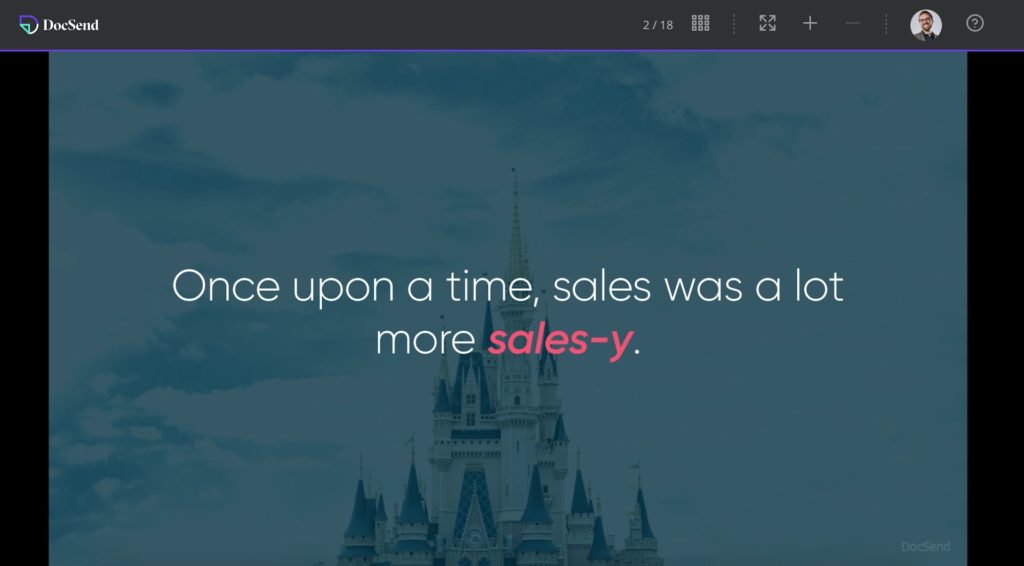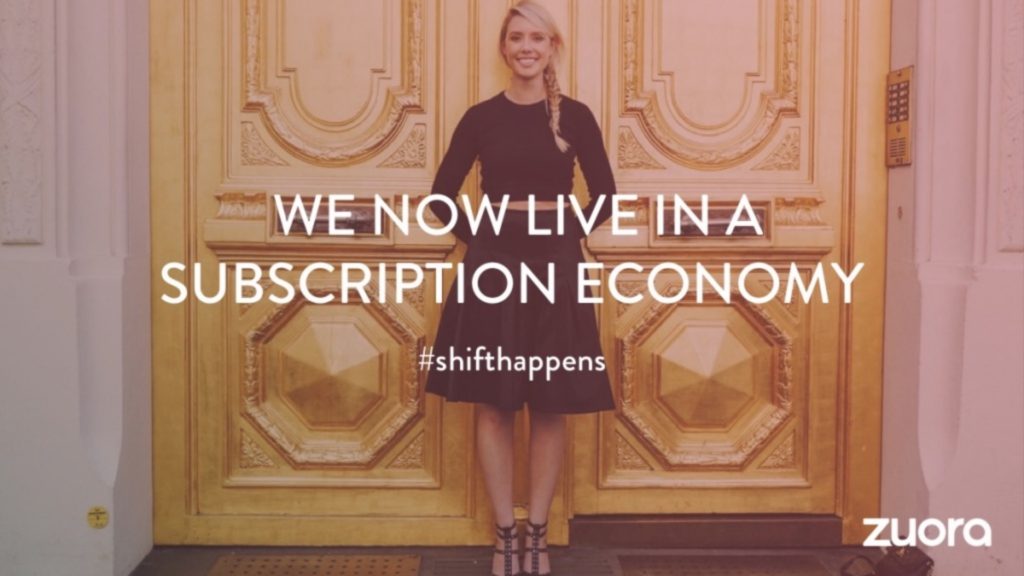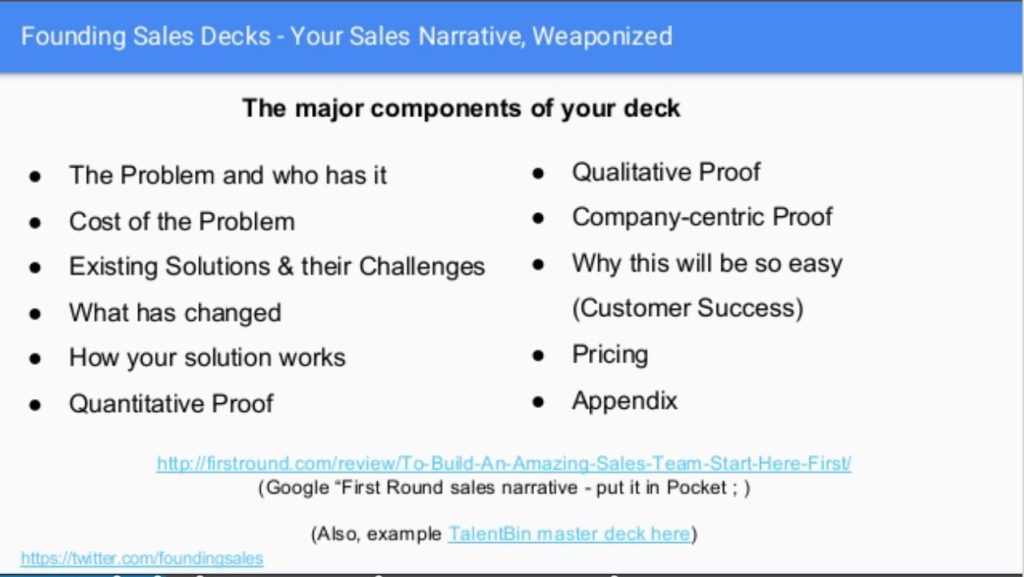If you want to close deals, you need sales decks.
The demo-only approach doesn’t work anymore. With an average of 6.8 people involved in each B2B deal, you need sales decks that can carry your message from the champion you met to the buyer you didn’t.
Together with 18 of the top minds in sales, I’ve assembled this complete guide to sales decks that wow and convert.
Too busy to read? Jump to the SlideShare version.
Table of contents
- What is a sales deck?
- What should a sales deck include?
- What are the key elements of a great sales deck?
- Part 1. How to build out your storyline
- Part 2. How to customize and visualize content
- Part 3. Best practices for creating your sales deck
- Sales deck examples
- BONUS: Check out the full SlideShare version
What is a sales deck?
A sales deck is a slide presentation which is produced in PowerPoint or Slides, which is shown in meetings with prospects to help explain your company’s product and why they need to buy. It’s used to supplement a sales pitch and a demo.
What should a sales deck include?
A sales deck needs to say who you are and what problem you are trying to solve. It needs to outline the “before” state when the prospect has a problem, and the “after” state when that problem is solved. The presentation needs to show how you will get the prospect from one state to the other.
We’ll look in more detail at how that’s done, below.
What are the key elements of great sales decks?
Sales decks are critical to accelerating your sales process, and yet most end up in critical condition.
Here’s how we get them wrong:
1) Listing out product features rather than telling a story
2) Overloading slides with too much information
3) Presenting a document live that was meant to be read, or vice versa.
That’s why we built this guide — to help you build and present a more compelling sales deck in three key steps.
1) Building out your storyline
2) Customizing and visualizing content
3) Flexing the format based on your delivery method
I’ll illustrate this advice from industry experts with tactical examples, so you can put it into practice immediately.
Part 1. How to build out your sales deck storyline
“When you’re building your next sales deck, keep one thing in mind: Prospects don’t care about your product.” – Courtney Chuang, DocSend
“Story” is a buzzword in sales today. But for good reason.
Prospects remember 5-10% of statistics and 25% of images. But when there’s a story involved, retention shoots to 60-70%.
Why?
In this age of information overload, stories — not lists of features — are the best way to make your message stick.
To prove it, DocSend recently overhauled their sales deck. Here’s what they found:
“Once we overhauled the DocSend discovery deck, we saw our completion rate triple.
“This meant prospects were actually finding our story compelling enough to complete the entire deck.
“This was crucial because it meant prospects were ready to convert to the next stage of the sales process.”
How do you know which type of story to tell in your sales presentation?
It depends on the size of the company and with whom you are meeting.
In general, if you are speaking with a:
C-level executive: Tell a high-level strategic story like the now-famous Zuora deck. Use Andy Raskin’s framework as your guide.
Budget Holder (VP/Director level): Make your case with the pragmatic framework laid out by Pete Kazanjy in Founding Sales.
Practitioners (or a technical buyer): Rely on defining your category and executing a well-framed demo.
You can flex this depending on the size of your prospect, as well:
The CXO sales deck
Your goal here is to get high-level buy-in so that an executive believes not only in your product but also in your vision. Once they share this belief, they can offer tops-down pressure to accelerate your deal.
What goes into the CXO deck? Andy Raskin popularized this narrative framework in his now-famous post about Zuora’s deck entitled “The Greatest Sales Deck I’ve Ever Seen” (a staple for any enterprise sales team).
To give a quick overview of his work, here are the core elements you’ll need:
The most important piece of this narrative is your opening. What’s the big change in the world that made your company not only nice, but necessary?
How do you know what that big change is? The best resources are your happiest customers.
Pick 4-6 customers most passionate about your product and ask them:
- What has fundamentally changed in your business in the past year?
- If your business fails, what will be the cause?
- What companies do you align yourself with, and why?
- Finally, how has [Product X] impacted your company?
From here, you will start to see patterns to show you how to present your story from the perspective of the buyer, not the seller.
The Budget Holder Proposal sales deck
This is the “brass tacks” sales deck for the budget holder who actually makes the purchase.
Your goal here is to give this person confidence in the ROI of your solution by de-risking the decision to accelerate the purchase.
A solid resource here is Peter Kazanjy’s Founding Sales work outlined in First Round Review. To share the highlights, here are the core elements of this type of sales narrative:
In this logical sell, you need to nail your ROI argument.
Where the CXO deck is propped up on a big change in environment or culture, this narrative is founded on cost of the problem today:
Starting with the cost of the problem tees you up to position your solution as a true creator of value, enabling your buyer to make the price of your solution a no-brainer.
The Practitioner’s Demo sales deck
With this sales deck, your goal is to drive adoption from the day-to-day future users of your product.
Don’t dive straight into a demo! Instead, build rapport and jumpstart bottoms-up adoption of your product by confirming the problem, then build from there.
Here’s what it looks like:
Start by framing your demo with the problem they are looking to solve.
Then, prioritize the demo accordingly.
Orchestrate your demo as a series of moments that directly address the problems they have highlighted.
For example: If your product has 6 key features, just highlight the 3 that most directly address the problem they are looking to solve.
Part 2: How to customize and visualize content
Even if you haven’t seen the latest MarTech 5000 slide, you’ve undoubtedly felt the overload first hand.
With more companies than ever competing for your customer’s attention, this is what you are up against:
How do you break through? Customization and visuals.
Why is customization important for sales decks?
Personalized emails earn 26% higher click-through rates, and deliver up to 6X higher transaction rates per email.
So you can imagine the impact of personalizing your sales decks.
Why are visuals important for sales decks?
Over 65% of people learn best visually, and visual presentations are 43% more persuasive than bullet-point ones.
If you don’t believe the statistics, look at the behavior of your coworkers:
Moments before a meeting, they are scrolling through Instagram, Slacking GIFs, and texting emojis. Afterward, they are checking Snap stories, liking Facebook photos, and commenting on LinkedIn videos.
How do you expect your bullet point slides to compete?
They can’t.
How to customize your sales deck
Regardless of which storyline you are using, you have opportunities to customize your deck periodically throughout. The most important slide to do this is your opening.
“Your first slide needs to be about what you’ve learned from YOUR CUSTOMERS. Use the voice of your customers to give you credibility.” – Doug Landis
To really stand out, you can customize your deck to your prospect’s brand as well. Standard practice is dragging and dropping in logos, but you can take it a step further and use your prospect’s brand colors as a theme throughout.
How to visualize your sales deck content
Here are a few ideas:
Use visual metaphors to tell the story
Before customers buy anything, they have to understand what it is.
Sounds simple, but so many companies (particularly highly technical products) mess this up. Big time.
Metaphors enable your prospect to instantly grasp what you’re trying to do.
Drift’s CEO David Cancel does this well when he describes Drift as the sales attendant in your store (your website). This metaphor – and the visual to go with it – elicits an emotional response that sticks with you far longer than a feature list could.
Use simple visual diagrams in your sales deck
As salespeople, we aren’t trained in art, because art is not our job.
Communication is our job.
Visuals are an incredibly efficient and memorable way to convey information, because our brains process visual information 60,000x faster than text. And we retain 4X more information we see vs. read.
Don’t get too complicated! With slides, less is more.
Here are some examples of simple visual layouts good for sales slides:
Bonus: How to visualize your case studies
The purpose of case studies is to provide credibility and proof your solution works. Nothing accomplishes this better than a visual case study:
In other parts of your presentation, iconography can be powerful tools to build a shared story.
Because icons are conceptual, your customer has to do some of the “work” to imagine the new future with your product.
When it comes to the case study, though, you want to make the examples as concrete — and credible — as possible.
Use photographs and videography to demonstrate that these other customers aren’t just ideas, but they are real, relatable people, too.
Part 3. Best practices for creating your sales deck
“Maybe your marketing team made you a beautiful one but they’re ONLY meant for explaining live, not showing to a decision maker offline.” – Cole Fox, LeadIQ
You just gave a compelling presentation to the end-users of your product, using your new practitioner’s framework. As you’re wrapping up the call, your prospect asks, “Can you send me something I can send my boss?”
What you don’t want to do is send the deck you just presented.
Here’s what to do.
Make multiple versions of your sales deck for different delivery modes
Never send someone your presentation deck to read.
Why?
Slides for presentation decks should contain a maximum of 20 words. That’s because the slides are simply support for your verbal presentation. Without you there to deliver the context, any reader of your presentation deck is going to be confused.
Instead, make a version of your deck aimed at readers. Limit your text to 60 words per slide for a deck to read. Given average reading speeds, a 10-slide deck with 60 words per slide will take about 5 minutes to read — the maximum you’d expect to get from a CXO.
Here’s what this looks like in practice.
Split your content into two text boxes in the original deck design for your 60-word version:
Then, when it’s time to present, just remove the body text boxes for your 20-word version:
Finally, more and more buyers are viewing content on mobile devices (up to 42% are using mobile devices during the purchase process), which should further limit the text density of your content.
If this is the case, your targets should be at least half the aforementioned limits (30 words instead of 60 for a read-ahead), as reading speeds slow significantly when moving from a full screen to a mobile device.
Sales deck examples
We’ve drawn our inspiration from three examples in particular:
DocSend Sales Deck Example

Zuora Sales Presentation Example

Sales Deck Examples for Founders

Sales presentations for founders
Finally, here are some more great sales presentation examples.
Check out the full SlideShare version of this guide here
https://www.slideshare.net/saleshackerconference/the-sales-hacker-deck-on-sales-decks-89290189
Published Jan. 2018. Updated Jan. 2023.







